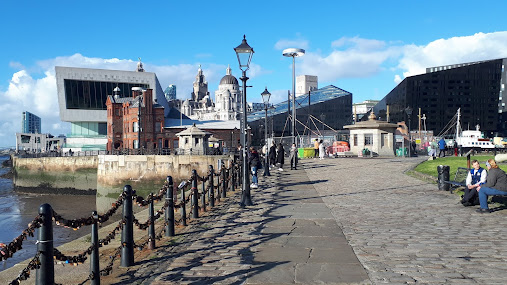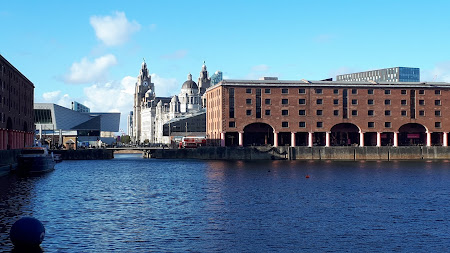Back in August I railed against UNESCO for retracting the world heritage status of the Liverpool Maritime Mercantile City. The other week I was back in that area of Liverpool for the first time in over 15 years. The area around the pier head, the Three Graces and the Albert Dock was outstanding then. But there has been lots of change. As the Liverpool Echo said a few days ago in an article covering all the major new buildings of that period "if you haven’t been in the city for a few years, it’s likely the view may not be exactly as you left it."
Although I've read about various proposals and actual developments, together with all the hyperventilation over UNESCO's decision, I hadn't realised just how much development had taken place in that time. I was, however, aware that some of the new buildings, sandwiched between the Three Graces and the Albert Dock on an area known as Mann Island, were conspicuously modern in appearance. This area was previously occupied by rundown warehouses and dock buildings and Liverpool city council had tried nearly 20 years ago to build a "fourth grace" on the site. A competition yielded three proposals, all of which were criticised for their appearance and contrast to the city's skyline. Work on the chosen option was cancelled in 2004. Subsequently the three mixed-use Mann Island buildings were completed by 2011 and the adjacent Museum of Liverpool by 2012.
To the north of the pier head there has been a lot of construction. Some of the buildings are tall enough that I had seen them from well outside the city centre. West Tower, completed in 2008, is Liverpool's tallest building. Indeed at 134m tall it is the tallest building in the UK outside of London and Manchester. It overtook the Radio City Tower, built in 1969 and in it's time seen as both controversial and an eyesore. The Radio City Tower is still known to us as St John's Beacon as it was originally named after the adjacent St John's market, not the Liverpool centre forward of the era in which it was built. Its futuristic design had an observation deck and restuarant with spectacular views. That restaurant and a successor had closed by 1983 leaving the tower empty and derelict. The tapering concrete column with the non-functioning revolving top section understandably became seen as an embarassing white elephant by Liverpudlians. But in the late 90s it was refurbished by Radio City as studios and office space. By 2020 it had been grade II listed by Historic England who decsribed it as "embodying the technological bravura and spirit of the space age". Which just goes to show how opinions can change.
But, unlike West Tower, the Radio City Tower is not immediately adjacent to the what was previously the tallest building near the waterfront, the Liver building. More recently the Lexington, completed in 2021, has also surpassed the height of the Liver Building. These skyscapers (for that is what they are) are in between the historic waterfront area and the site of Everton's new stadium, the development which seemed to be the final straw for UNESCO.
We were in Liverpool to see Genesis play a gig at the Liverpool Arena, re-arranged from 2020 due to covid. The Arena was built on the site of the former King's Dock which had been the location proposed for Everton's new stadium in the 1990s. That project fell through in 2003 - my recollection is that Everton could not come up with a measly £30m to secure the site. The two branch docks which formed King's Dock and connected Wapping Dock and Queen's Dock were filled in, just as is now being done at Bramley-Moore. According to Wikipedia the Arena project, completed in 2008 utilising the space of what were the two docks and adjoining vacant land, became "an exemplary case of brownfield land development".
A few years later, the reception for the controversial Mann Island buildings was mixed. The Daily Post, shortly before its demise, lamented the loss of several key views of the Pier Head (then) world heritage site. The buildings were nominated for the Carbuncle Cup, an architecture "prize" given annually by the magazine Building Design to the "ugliest building in the United Kingom completed in the last 12 months". It didn't win, though three years earlier the new Liverpool Ferry Terminal had been given the dubious accolade. Looking like a "stick of rock" or, to me, a rather angular version of the Lord's cricket ground media centre, the terminal sits, of necessity, at the Pier Head and so full centre of the view of the historic waterfront from the river.
Anyway, enough of what others have said. What did we think after driving into the city from the north, past the new skyscrapers, parking up by Albert Dock and walking along the waterfront King's Parade towards the Pier Head on a beautiful early autumn afternoon? Here's a picture I took as we reached the end of the Albert Dock buildings to see the interrupted view of the Three Graces:
On the far left you can see one of the new towers, then the ferry terminal towering over the 19th century brick Piermaster's House and obscuring most of one of the twin Liver Building towers. Then West Tower peeping through between the two towers of the Liver Building and then the dome of the Port of Liverpool building, partly obscured by one of the two black angular Mann Island buildings. The second angular Mann Island building to the right hides most of the more regular third building.
We thought this eclectic jumble of preserved old and new modern was - absolutely fantastic and inspirational. Had we walked further in that direction the full view of the Three Graces would have opened up. Sometimes, as all good gardeners know, it's better for a view to open up in stages, rather than all at once.
But instead we turned right and went into the Albert Dock complex. The whole area around Albert Dock buzzes with far more eateries, as well as museums, than on our last visit. Here's another photo,with a clear view of the new buildings on the left and theThree Graces on the right between buildings of the Albert Dock:
And here's what was Liverpool's tallest building before St John's Beacon and the new towers came along*, the Anglican Cathedral, peeping through the Albert Dock buildings looking east:
We thought we knew the area well but we ran out of superlatives. It was a revelation. As were Genesis that evening.
So that's a big thumbs up from me and Mrs H and one in the eye for UNESCO.
As I said before: UNESCO can do one. Liverpool should have no regrets about moving forward. I know the city council has a desevedly dodgy reputation but, as someone who now counts as a tourist, I can only say "great job".
* Pedants might point out that the Anglican Cathedral wasn't completed until 1978. But as it was started in 1904 the structure had stood on St James's Mount, a bit more than a mile from the Pier Head, glowering over the city from long before the upstart Beacon was built. I've never heard it referred to by it's proper name (Liverpool Cathedral). It's called the Anglican to distinguish it from the other one, the Roman Catholic cathedral universally known as Paddy's Wigwam because of it's shape and which I have also never heard referred to by its proper name, the Liverpool Metropolitan Cathedral. Scousers, eh?
References:
Liverpool's iconic changing skyline captured in images down the years. Liverpool Echo, 20 October 2021. https://www.liverpoolecho.co.uk/news/nostalgia/liverpools-iconic-changing-skyline-captured-21886276
Mann Island Buildings, Wikipedia
List of tallest buildings and structures in Liverpool, Wikipedia
Ferry Terminal's carbuncle award. BBC 4 Sept 2009, http://news.bbc.co.uk/1/hi/england/merseyside/8226211.stm



No comments:
Post a Comment